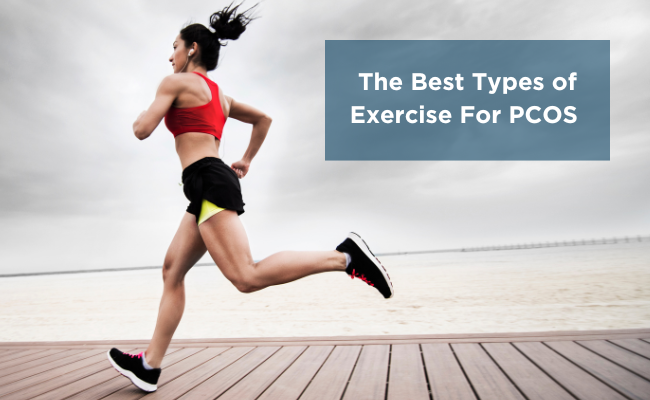
The Best Types of Exercise For PCOS

by Krista Russ
September 28, 2023
Exercise is important to general health as well as for managing PCOS. Moving your body in any way is likely to benefit PCOS because it increases insulin sensitivity, but for the most benefit, exercise in your target heart rate zone, meaning at a moderate to vigorous intensity. This ensures that you’re placing enough stress on your body for your heart, lungs, and muscles to adapt and become stronger, producing health benefits like a reduction in long-term PCOS complications, such as heart disease. Some the best exercises for PCOS include:
- Strength Training
- HITT (High Intensity Interval Training)
- Vigorous Aerobic Exercise
We will discuss the first two exercises in this article and vigorous aerobic exercise in a future blog.
To find a doctor near you, simply search the Bio-Identical Hormone Therapy (BHRT) Provider Directory.
What is Strength Training?
Strength training, also known as resistance training, includes a variety of exercises ranging from calisthenics to plyometrics to sprinting. All these strength-building activities are considered anaerobic. Anaerobic exercise is done without oxygen and can therefore only be sustained in short bursts. For example, you can sprint for a few seconds, but then you must stop and catch your breath—unlike jogging which can be done for much longer. This kind of exercise is great for building muscle, which has a two-fold benefit for PCOS; it both increases your metabolic rate and improves insulin sensitivity.
Lastly, anaerobic exercise causes your body to burn more sugar rather than fat (fat is preferentially burned at lower intensities), which aids in blood sugar control and insulin sensitivity. For more on the benefits of strength training for PCOS, including a sample workout regimen to get started, download our eBook.
What is HITT?
High Intensity Interval Training also known as HIIT involves cycling intervals of lower intensity activity with intervals of very high intensity activity, such as five minutes of light jogging followed by 2-3 minutes of sprinting and then repeating for 4-6 cycles.
HIIT combines aerobic with anaerobic/strength exercise, giving you the best of both worlds. Because these workouts are tough, they are usually short, ranging from 15-30 minutes, but effective.
For example, a PLoS one [1] study found that after ten weeks of training, women who did HIIT experienced a greater decrease in insulin resistance than women who performed strength training—although strength is still very beneficial.
It’s important that you already have a foundation in fitness before attempting this kind of intense workout and always warm-up and stretch for 5-10 minutes beforehand to prevent serious injury.
The Bottom Line
We have only scratched the surface of how these exercises can benefit PCOS. Remember to start slow and increase with time. Consistency is more important than doing a crazy workout that’s unsustainable. Any movement is better than no movement. Even getting up to stretch or walk for a few minutes every hour while working at your desk can improve your health and lower your risk for chronic disease [2], [3].
Your Cardio-respiratory fitness is a very important marker for long-term health—whether you have PCOS or not, but for PCOS, it is perhaps even more important because it has potential to prevent serious future health risks like heart disease and diabetes.
For a sample HITT and strength training workout regimen designed just for women with PCOS, as well as guidance on gauging your progress, be sure to download our eBook.
And as always, to best improve your health, we strongly recommend you speak with an APIM | WLM Trained Provider, who can help you form a personalized blueprint to support your wellness based around a variety of strategies, including diet, hormones, and supplements pertaining to your specific health goals.
Sources:
Almenning I, Rieber-Mohn A, Lundgren KM, Shetelig Løvvik T, Garnæs KK, Moholdt T (2015) Effects of High Intensity Interval Training and Strength Training on Metabolic, Cardiovascular and Hormonal Outcomes in Women with Polycystic Ovary Syndrome: A Pilot Study. J PLoS ONE 10(9): e0138793. https://doi.org/10.1371/journal.pone.0138793 https://journals.plos.org/plosone/article?id=10.1371/journal.pone.0138793
Time to Move. University of Michigan Human Resources. Accessed August 5, 2023. https://hr.umich.edu/benefits-wellness/health-well-being/mhealthy/faculty-staff-well-being/physical-activity/time-move
Reynolds G. Move for 3 minutes, every half-hour, to counter the ill effects of sitting, new study finds. The Seattle Times. Updated September 8, 2021. Accessed August 4, 2023. https://www.seattletimes.com/nation-world/move-for-3-minutes-every-half-hour-to-counter-the-ill-effects-of-sitting-new-study-finds/